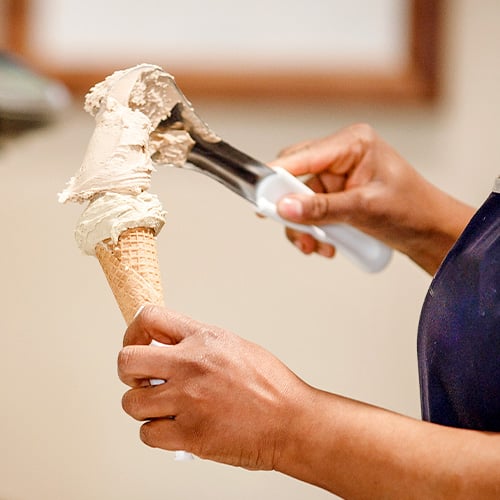Snow ice is a frozen dessert made by combining milk with flavored powders, syrups, or fruit purees, freezing it, and then shaving the frozen mixture into delicate layers using a specialized machine. The result is a light and fluffy texture that resembles freshly fallen snow, hence the name "snow ice." Since it looks like a perfectly stacked pile of snowflakes, it's almost too pretty to eat. When desire overcomes self-control, the frozen ribbons melt into a creamy, ice cream-like liquid on your tongue. This dessert is typically served with a variety of toppings such as fresh fruits, sweetened condensed milk, flavored syrups, and different types of boba, adding layers of taste and texture to the overall experience. Snow ice is a versatile, visually appealing, and cost-effective dessert option to help boost your business's bottom line by attracting new customers, increasing your revenue, and establishing your sweetery as a go-to destination for novel desserts. Shop All Snow Ice Powders Learn about snow ice: Where Is Snow Ice From? Shaved Ice vs Snow Ice How to Make Snow Ice Popular Snow Ice Dessert Flavors Snow Ice Toppings Ideas Business Models That Benefit from Offering Snow Ice Where Is Snow Ice From? Also known as xue hua bing in Chinese, which translates into “Snowflake Ice,” snow ice is a popular Taiwanese dessert. It was invented at the renowned Shilin Night Market in Taipei, Taiwan. This innovative dessert quickly gained popularity in Taiwan before spreading to other parts of Asia and eventually migrating to the United States and beyond. Shaved Ice vs Snow Ice While both shaved ice and snow are made from ice, they differ significantly in their ingredients, preparation methods, and textures. Shaved ice is a classic treat that exclusively uses water to make its ice blocks. The ice is shaved into thin flakes, creating a light yet toothsome texture. Commonly known as "shave ice" in Hawaii, this dessert is typically topped with flavorful snow cone syrups, making it a simple yet delightful option for cooling off on a hot day. Compared to snow ice, shaved ice more closely resembles a snow cone. Snow cones are made by crushing ice into a coarser, granular texture. The larger ice crystals in snow cones give them a crunchier texture. Snow ice takes a different approach by combining milk, fruit, and syrups into an ice block before freezing. This unique method infuses the dessert with more flavor than shaved ice. Taiwanese snow ice shavers then use a razor-sharp blade to shave the flavored ice into ribbons, giving it a fluffy “snow-like” consistency. The result is a smooth and creamy dessert that more closely resembles ice cream than traditional shaved ice. While shaved ice offers a light and refreshing treat, snow ice provides a more decadent and flavorful experience. The fluffy texture of snow ice sets it apart from the thin flakes of shaved ice, making it a popular choice for those looking for a more indulgent frozen dessert option. How to Make Snow Ice To make snow ice efficiently, you will need a snow ice machine specifically designed for this purpose. These machines are equipped with sharp blades and precise controls to ensure the fluffy texture and consistency that sets snow ice apart from shaved ice or snow cones. By following these steps and tips, you can create delicious and visually stunning snow ice desserts. Ingredients: The base ingredients for snow ice typically include milk, sugar, and flavorings such as fruit purees, powders, or syrups. These ingredients are mixed to create a smooth and creamy liquid base. Freezing: The liquid mixture is then poured into a specialized snow ice machine, capable of both freezing it and shaving it into thin layers. This process creates the signature fluffy texture of snow ice. Shaving: The frozen mixture is shaved into delicate ribbons using a blade or scraper attachment in the machine. The thin layers of snow ice are collected into a bowl or cup, ready to be served. Serving: Snow ice is typically served in a bowl or cup, adorned with various ice cream toppings such as fresh fruit, nuts, or sweetened condensed milk. Bubble tea toppings are also extremely common. The light and airy texture of snow ice allows it to absorb flavors and toppings beautifully. Popular Snow Ice Dessert Flavors This fluffy, icy treat is versatile and can be customized with a variety of flavors to suit different preferences. If you're starting an ice cream shop and adding snow ice to your menu, here are some popular snow ice flavors customers have proven they love. Mango: This tropical fruit adds a sweet and tangy flavor to snow ice. Its vibrant color and refreshing taste make it a popular choice among customers looking for a fruity and exotic treat. Cube fresh mango and incorporate it into your ice mixture before freezing for an even fresher flavor. Matcha: A finely ground green tea powder, matcha is a beloved flavor in Asian desserts. When combined with snow ice, it offers a delicate balance of earthy and sweet notes that appeal to customers who enjoy a hint of bitterness in their desserts. Taro: A root vegetable with a mildly sweet flavor, taro is a popular choice for snow ice due to its creamy texture and unique taste. Taro snow ice is often paired with coconut or condensed milk for a rich and satisfying dessert experience. Chocolate: For those craving a classic dessert flavor, chocolate-flavored snow ice is a decadent option. Whether it's dark chocolate, milk chocolate, or white chocolate, this indulgent treat is sure to satisfy almost any sweet tooth. Vanilla: A classic flavor that never goes out of style, vanilla snow ice offers a simple yet satisfying taste that pairs well with a variety of toppings and syrups, making it a versatile option for any dessert menu. Use a high-quality vanilla flavoring for the best taste. Strawberry: Providing a burst of fruity sweetness, strawberry snow ice is a delightful choice. The vibrant red color and juicy flavor of strawberries make this flavor a popular option for customers of all ages. Lychee: A tropical fruit with a sweet and floral taste, lychee is a unique flavor option for snow ice. Its aromatic flavor profile adds a refreshing twist to the traditional dessert, making it a popular choice for those looking for something new. Coffee: For those who enjoy the rich and robust flavor of coffee, coffee-flavored snow ice is a perfect choice. It's often enhanced with a sweet and creamy topping like vanilla ice cream, sweetened condensed milk, or whipped cream to create a delicious dessert that combines the best of both worlds. Snow Ice Toppings Ideas One of the key attractions of snow ice is its light, fluffy texture, which complements a wide variety of ice cream toppings, allowing for endless creativity in flavor combinations and presentations. Experiment with different combinations of toppings to create unique and delicious snow ice creations that cater to diverse taste preferences. Condensed Milk: A traditional Taiwanese snow ice topping, drizzling condensed milk over snow ice enhances its sweetness and creaminess. Its thick and rich consistency adds a luscious finish to the dessert. Fresh Fruits: Enhance the freshness and natural sweetness of snow ice by topping it with a variety of fresh fruits such as strawberries, blueberries, mangoes, or kiwis. These colorful and flavorful additions not only provide a burst of freshness but also add a visually appealing touch to the dessert. Jellies and Boba: Incorporating popular bubble tea toppings can provide a unique textural contrast and a burst of flavor. Options like fruit jellies, tapioca pearls, or popping boba create a fun, interactive element to the dessert, making each bite a delightful surprise. Sweet Sauces: Drizzling sweet sauces like chocolate syrup, caramel sauce, or fruit coulis over snow ice can elevate its taste profile and create a decadent dessert experience. These sauces add richness and depth to the overall flavor while complementing the lightness of the shaved snow. Nuts and Seeds: For added texture and nutty flavor, consider sprinkling chopped nut varieties like almonds, pistachios, or peanuts on top of the snow ice. Additionally, seeds such as chia seeds or sesame seeds can provide a crunchy contrast to the soft and creamy base. Candies and Sprinkles: For a playful and colorful twist, consider adding candies, chocolate chips, or different types of sprinkles as toppings for snow ice. These sweet and crunchy additions not only enhance the visual appeal of the dessert but also offer a fun and indulgent element to the overall flavor profile. Whipped Cream and Ice Cream: For an extra indulgent touch, top snow ice with a dollop of whipped cream or a scoop of ice cream. The creamy richness of these additions pairs well with the light and airy texture of the shaved snow, creating a luxurious and satisfying dessert experience. Bonus points if you make your own whipped cream. Business Models That Benefit from Offering Snow Ice Not just for ice cream parlors, a wide range of businesses can benefit from adding light, creamy, and unique snow ice to their menu. Bubble Tea Shops: Since both snow ice and boba tea have their origins in Taiwan, adding snow ice to your bubble tea shop menu is a natural choice. The light and fluffy texture of snow ice provides a refreshing and indulgent treat that pairs well with the bold flavors of bubble tea. By showcasing their snow ice creations online, bubble tea businesses can attract new customers and generate buzz around their brand. Dessert Shops: Dessert shops that specialize in offering a wide range of sweet treats can benefit from adding snow ice to their menu. Snow ice provides a refreshing option for customers looking for a unique dessert experience. Cafes and Coffee Shops: Cafes and coffee shops can attract new customers and increase sales by offering snow ice as a refreshing treat to pair with their coffee drinks. The light and creamy texture of snow ice can complement the rich flavors of coffee and tea. Asian Restaurants: Asian restaurants, especially those that serve Taiwanese or Korean cuisine, can benefit from adding snow ice to their dessert menu. Snow ice is a popular dessert in many Asian countries and can appeal to customers looking for an authentic and delicious ending to their meal. Food Trucks: Known for their innovative and creative food offerings, food trucks can attract customers by incorporating snow ice into their menu. The vibrant colors and customizable flavors of snow ice make it an appealing option for food truck owners wanting to offer something different and eye-catching to their customers. Caterers: Catering services can stand out from the competition by offering snow ice as a unique and eye-catching dessert option. Snow ice can be easily customized with different flavors and toppings, making it a versatile choice for on-the-go dining experiences. Frozen Yogurt and Ice Cream Shops: Frozen yogurt and ice cream shops can expand their offerings by adding snow ice to their menu. Snow ice provides a lighter alternative to traditional ice cream and can attract customers looking for a healthier dessert option. Snow ice offers a unique texture and taste not found in any other frozen dessert. By offering this trendy and novel sweet treat, businesses can stay ahead of the competition and cater to customers' evolving tastes. Whether you operate an ice cream parlor, Asian restaurant, or bubble tea shop, consider adding snow ice to your offerings.






